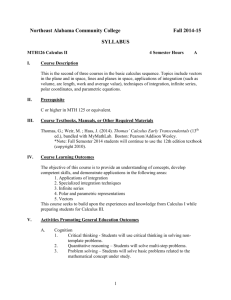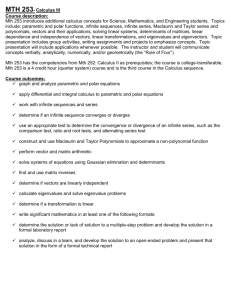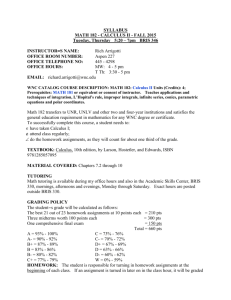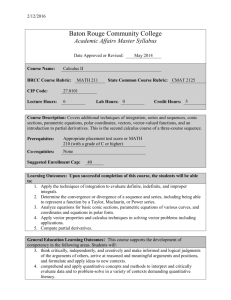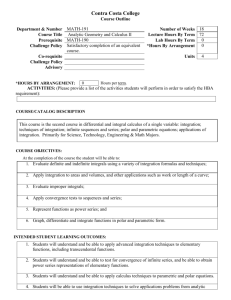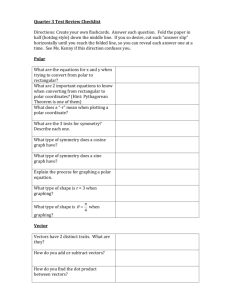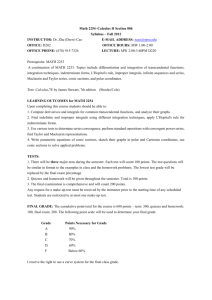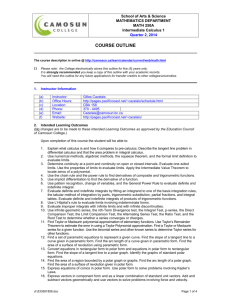WESTERN OKLAHOMA STATE COLLEGE
advertisement
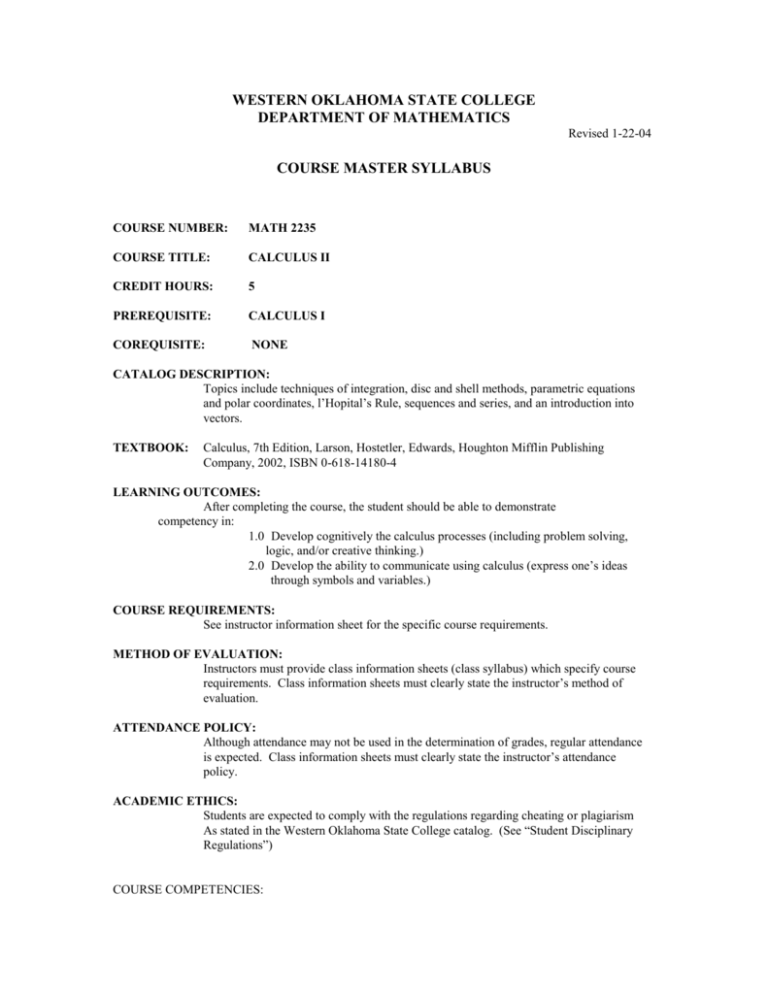
WESTERN OKLAHOMA STATE COLLEGE DEPARTMENT OF MATHEMATICS Revised 1-22-04 COURSE MASTER SYLLABUS COURSE NUMBER: MATH 2235 COURSE TITLE: CALCULUS II CREDIT HOURS: 5 PREREQUISITE: CALCULUS I COREQUISITE: NONE CATALOG DESCRIPTION: Topics include techniques of integration, disc and shell methods, parametric equations and polar coordinates, l’Hopital’s Rule, sequences and series, and an introduction into vectors. TEXTBOOK: Calculus, 7th Edition, Larson, Hostetler, Edwards, Houghton Mifflin Publishing Company, 2002, ISBN 0-618-14180-4 LEARNING OUTCOMES: After completing the course, the student should be able to demonstrate competency in: 1.0 Develop cognitively the calculus processes (including problem solving, logic, and/or creative thinking.) 2.0 Develop the ability to communicate using calculus (express one’s ideas through symbols and variables.) COURSE REQUIREMENTS: See instructor information sheet for the specific course requirements. METHOD OF EVALUATION: Instructors must provide class information sheets (class syllabus) which specify course requirements. Class information sheets must clearly state the instructor’s method of evaluation. ATTENDANCE POLICY: Although attendance may not be used in the determination of grades, regular attendance is expected. Class information sheets must clearly state the instructor’s attendance policy. ACADEMIC ETHICS: Students are expected to comply with the regulations regarding cheating or plagiarism As stated in the Western Oklahoma State College catalog. (See “Student Disciplinary Regulations”) COURSE COMPETENCIES: 1.0 Develop cognitively the calculus processes (including problem solving, logic, and/or creative thinking.) 1.1 using volumes of surfaces of revolution, 1.2 using arc length of a curve, 1.3 using centers of mass and centroids, 1.4 using techniques of integration, 1.5 using L’Hopital’s Rule, 1.6 using improper integrals, 1.7 by recognizing and manipulating sequences and series, 1.8 by testing for convergence of sequences and series, 1.9 by applying Taylor and Maclaurin series, 1.10 using parametric equations, 1.11 using polar equations, 1.12 using vector operations 2.0 Develop the ability to communicate with calculus (express one’s ideas through symbols and variables.) 2.1 using volumes of surfaces of revolution, 2.2 using arc length of a curve, 2.3 using centers of mass and centroids, 2.4 using techniques of integation, 2.5 using L’Hopital’s Rule, 2.6 using improper integrals, 2.7 by recognizing and manipulating sequences and series, 2.8 by testing for convergence of sequences and series, 2.9 by applying Taylor and Maclaurin series, 2.10 using parametric equations, 2.11 using polar equations, 2.12 using vector operations OBJECTIVES: 1.0 To demonstrate competency for in applications of integration the student should be able to: 1.1 1.2 1.3 1.4 1.5 1.6 1.7 find the area between two curves, find volumes of surfaces of revolution by using the disc method, find volumes of surfaces of revolution by using the shell method, find arc length of a curve, apply integration to find solutions of problems involving work, apply integration as related to centers of mass and centroids, calculate fluid pressure and fluid work. 2.0 To demonstrate competency for techniques of integration, l’Hopital’s Rule, and improper integrals the student should be able to: 2.1 2.2 2.3 2.4 2.5 2.6 integrate by parts, evaluate trigonometric integrals, integrate using trigonometric substitution, integrate by partial fractions, recognize and evaluate intermediate forms using l”Hopital’s Rule, evaluate improper integrals. 3.0 To demonstrate competency for infinite series the student be able to: 3.1 3.2 3.3 3.4 3.5 3.6 3.7 3.8 3.9 recognize and manipulate sequences, manipulate series, identify a p-series, use the integral test, test a series by the comparison test, identify and evaluate alternating series, use the ration and root tests, represent functions by the power series, to use Taylor and Maclaurin series. 4.0 To demonstrate competency for parametric equations and polar coordinates the student should be able to: 4.1 4.2 4.3 4.4 4.5 4.6 4.7 write sets of parametric functions, understand the usages of calculus with parametric equations, convert from polar to rectangular coordinates, convert from rectangular to polar coordinates, graph polar equations, find the area of a polar region, fund the arc length of a polar curve. 5.0 To demonstrate competency for vectors and the geometry of space the student should be able to: 5.1 find vector length, 5.2 know the properties of vector operations, 5.3 find a unit vector, 5.4 write a vector as linear combination of unit vectors, 5.5 find a resultant force using vectors, 5.6 find the distance between two points in space, 5.7 understand vectors in space, 5.8 use the definition of parallel vectors, 5.9 perform a dot product, 5.10 find the angle between two vectors, 5.11 use the definition of orthogonal vectors, 5.12 find projections of one vector onto another, 5.13 find the cross product of two vectors in space, 5.14 use properties of the cross product, 5.15 write parametric equations of a line in space, 5.16 find the distance between point and a plane, 5.17 convert from rectangular to cylindrical and spherical coordinates.
